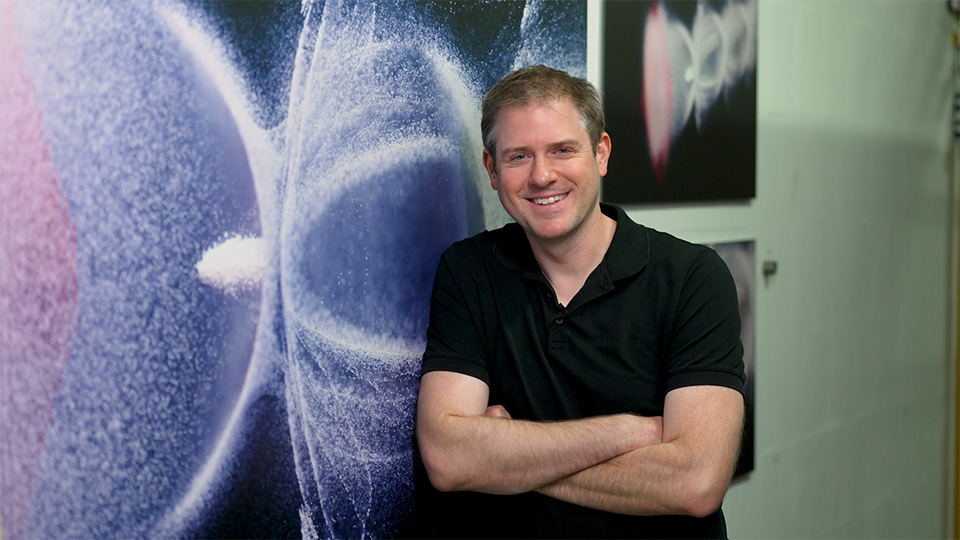Andreas Maier wins the 2025 Bjørn H. Wiik Prize
An interview with the plasma accelerator expert and prize winner.
He is one of the world's leading experts in the field of laser plasma acceleration: Andreas Maier, physicist, joined DESY in 2020, a lead scientist since 2022. A man of action for whom a visit to the laser laboratory is inspiring "quality time". A strategist with foresight who translates visions into measurable results. This year, he and his team achieved internationally acclaimed research successes – game changers on the path to practical application of this still young technology, including for DESY's future project PETRA IV. "Belief in feasibility is a prerequisite for realisation," says Andreas Maier with conviction. Now he is being honoured with DESY's most important science award, the Bjørn H. Wiik Prize. An interview with the award winner:
Andreas Maier, where does your fascination with laser plasma acceleration come from?
It began when I was studying physics more than 20 years ago. Originally, I was interested in stars, in astrophysics. On a star-gazing excursion to Namibia, I met a colleague while walking through the desert who told me how he makes electrons surf and accelerates them to high energies in a plasma. At the time, this was a completely new field of research at the Max Planck Institute in Munich. I found it so exciting that I applied to work there three or four years later. I've been hooked on the subject ever since.

What happened next?
During my Ph.D., I travelled to Stanford in California in 2009 with a research group for an experiment at the LCLS. As someone who develops plasma accelerators, it was the first time I had seen a classic accelerator, a user machine, in action. I was totally fascinated by how it worked and immediately thought: we absolutely must transfer these concepts to plasma acceleration. I just need to be in the right place to do that.
And that's why you went to Hamburg!
Immediately after completing my doctorate in 2012, I moved to the University of Hamburg on the DESY campus because of the connection between plasma and conventional accelerator technology. DESY simply knows how to build stable systems. It was definitely a strategic decision – and I stayed.
Has a lot changed in this field and for you personally since then?
I think people generally have a distorted perception of time: Objectively speaking, progress is very, very fast – but it feels much too slow. And personally, five years ago, I couldn't have imagined what my job would look like today, what the range of tasks would entail. The mere fact of leading a relatively large group in a very short time has changed a lot.
How big is your working group?
Including students, doctoral candidates, and postdocs, there are about 50 of us – a very young, dynamic group.
The word "revolutionary" is often used in connection with laser plasma acceleration.
Even a revolution takes a long time. An important first step – a milestone for us – was the first 24-hour operation of a laser plasma accelerator a few years ago. But we are currently working through a long list of tasks.
Another big word: "milestone". You and your team were the first to use a laser plasma accelerator to generate stable electron bunches that are similar in stability to those produced by modern radio frequency accelerators. You will also receive the Wiik Prize 2025 for this achievement.
These results are indeed milestones, although I must say that we achieved them by bringing together the best of two worlds: conventional accelerator technology and laser plasma acceleration. That's why it worked.
And that also increases confidence in this revolutionary technology.
That is precisely what is crucial! With our results, we are sending the message: It is possible, it can work if everyone works on it with full commitment – and really wants it. The current shift in thinking is perhaps the real milestone. Because belief in feasibility is a prerequisite for realisation. Then people also begin to work on implementation.
Your focus is consistently on application, which is also one of the criteria of the Wiik Prize jury. How close is the technology really to practical use, for example as an injector for DESY's future PETRA IV project?
We have shown that we can generate plasma electron beams that are stable enough for possible application, for example for injection into a storage ring. The next step is to show that we can actually inject electrons into the storage ring with the results we have achieved. Injection into DESY II and then into PETRA III is our big goal for the next year or two. To achieve this, a great many components from different areas at DESY have to come together. We need support from photon science and from our colleagues in the machine area. But colleagues from particle physics are also helping. We want to demonstrate that this technology can function reliably as an overall concept. We are working intensively on this.
You certainly have a strong inner conviction – but surely also a lot of external pressure...
Football coach Julian Nagelsmann recently said in an interview: “Pressure is a privilege”. I think we currently have a unique opportunity to seriously find out what plasma acceleration can do – and where we might still need to make improvements. That is precisely the essence of physics. We conduct experiments, evaluate them afterwards and think about the next steps. If there is one place where this technology can be successfully put into practice, it is at DESY! It's in the DNA of the accelerator sector, in the DNA of DESY, to build stable machines for users.
(The prize, worth 3000 Euro, will be awarded during DESY DAY on 5 November 2025 in memory of Bjørn H. Wiik, Chairman of the DESY Board of Directors, who died in 1999.)
